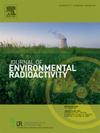阳江核电站污水公众剂量评估:南海氚运移的多媒体数值模型
IF 1.9
3区 环境科学与生态学
Q3 ENVIRONMENTAL SCIENCES
引用次数: 0
摘要
摘要核电厂的周期性排放影响了海水中的氚本底水平。福岛核事故发生后,放射性废水排放将大量氚引入海洋。这些事件可能威胁到海洋生态系统和人类健康。为了克服现有模型考虑介质不完全和精度低的局限性,我们开发了TrOSB模型(Tritium Ocean-Sediment-Biota transport model)。该高精度模型全面分析了多种海洋介质中的运输和转化,包括海水中的运输、与沉积物的相互作用、通过食物链的转移以及海产品消费的公众剂量风险评估。结果表明,阳江核电站在2019 - 2021年的季度排放过程中,氚在4个月内扩散到整个南海,呈现出明显的季节性运输模式。沉积物中的氚浓度比近底水体低约10倍,沉积物中未观察到明显的富集。通过食物链转移的有机结合氚(OBT)在鱼类中的富集程度高于软体动物和甲壳类动物。剂量评估表明,阳江核电站出水氚对公众健康的危害可以忽略不计。本文章由计算机程序翻译,如有差异,请以英文原文为准。

Public dose assessment for Yangjiang nuclear power plant effluents: A multi-media numerical model of tritium transport in the South China sea
Periodic discharges from nuclear power plant (NPP) influence tritium background levels in seawater. After the Fukushima nuclear accident, radioactive wastewater discharges have introduced substantial amounts of tritium into the ocean. These events potentially threaten marine ecosystems and human health. To overcome the limitations of existing models, such as incomplete media consideration and low precision, we developed the TrOSB model (Tritium Ocean-Sediment-Biota transport Model). This high-precision model comprehensively analyzes transport and transformation across multiple marine media, including transport in seawater, interactions with sediments, transfer through the food chain, and assessment of public dose risks from seafood consumption. Results indicate that during the quarterly discharges of the Yangjiang NPP from 2019 to 2021, tritium from effluents spread across the entire South China Sea within four months, showing distinct seasonal transport patterns. Tritium concentrations in sediments were approximately ten times lower than those in near-bottom waters, with no significant enrichment observed in sediments. Organically bound tritium (OBT), the form of tritium transferred through the food chain, was found to be enriched to a higher degree in fish than in molluscs and crustaceans. The dose assessment indicates that public health risks from tritium in Yangjiang NPP effluents are negligible.
求助全文
通过发布文献求助,成功后即可免费获取论文全文。
去求助
来源期刊

Journal of environmental radioactivity
环境科学-环境科学
CiteScore
4.70
自引率
13.00%
发文量
209
审稿时长
73 days
期刊介绍:
The Journal of Environmental Radioactivity provides a coherent international forum for publication of original research or review papers on any aspect of the occurrence of radioactivity in natural systems.
Relevant subject areas range from applications of environmental radionuclides as mechanistic or timescale tracers of natural processes to assessments of the radioecological or radiological effects of ambient radioactivity. Papers deal with naturally occurring nuclides or with those created and released by man through nuclear weapons manufacture and testing, energy production, fuel-cycle technology, etc. Reports on radioactivity in the oceans, sediments, rivers, lakes, groundwaters, soils, atmosphere and all divisions of the biosphere are welcomed, but these should not simply be of a monitoring nature unless the data are particularly innovative.
 求助内容:
求助内容: 应助结果提醒方式:
应助结果提醒方式:


